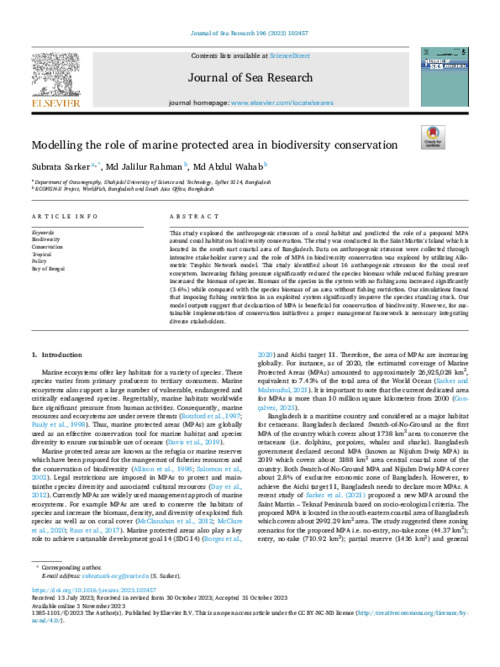Please use this identifier to cite or link to this item:
https://hdl.handle.net/20.500.12348/5755
Modelling the role of marine protected area in biodiversity conservation
| dc.creator | Sarker, S. | en_US |
| dc.creator | Rahman, M.J. | en_US |
| dc.creator | Abdul, W.M. | en_US |
| dc.date.accessioned | 2024-01-14T13:30:17Z | |
| dc.date.available | 2024-01-14T13:30:17Z | |
| dc.date.issued | 2023 | en_US |
| dc.identifier.citation | Subrata Sarker, Md Rahman, Wahab Abdul. (1/12/2023). Modelling the role of marine protected area in biodiversity conservation. Journal of Sea Research, 196. | en_US |
| dc.identifier.issn | 1385-1101 | en_US |
| dc.identifier.issn | 1873-1414 | en_US |
| dc.identifier.uri | https://hdl.handle.net/20.500.12348/5755 | |
| dc.description.abstract | This study explored the anthropogenic stressors of a coral habitat and predicted the role of a proposed MPA around coral habitat on biodiversity conservation. The study was conducted in the Saint Martin's Island which is located in the south east coastal area of Bangladesh. Data on anthropogenic stressors were collected through intensive stakeholder survey and the role of MPA in biodiversity conservation was explored by utilizing Allometric Trophic Network model. This study identified about 16 anthropogenic stressors for the coral reef ecosystem. Increasing fishing pressure significantly reduced the species biomass while reduced fishing pressure increased the biomass of species. Biomass of the species in the system with no fishing area increased significantly (3–6%) while compared with the species biomass of an area without fishing restriction. Our simulations found that imposing fishing restriction in an exploited system significantly improve the species standing stock. Our model outputs suggest that declaration of MPA is beneficial for conservation of biodiversity. However, for sustainable implementation of conservation initiatives a proper management framework is necessary integrating diverse stakeholders. | en_US |
| dc.format | en_US | |
| dc.language | en | en_US |
| dc.publisher | Elsevier (12 months) | en_US |
| dc.rights | CC-BY-NC-ND-4.0 | en_US |
| dc.source | Journal of Sea Research;196,(2023) | en_US |
| dc.subject | tropical | en_US |
| dc.subject | policy | en_US |
| dc.title | Modelling the role of marine protected area in biodiversity conservation | en_US |
| dc.type | Journal Article | en_US |
| cg.contributor.funder | United States Agency for International Development | en_US |
| cg.coverage.country | Bangladesh | en_US |
| cg.coverage.region | Southern Asia | en_US |
| cg.subject.agrovoc | biodiversity | en_US |
| cg.subject.agrovoc | conservation | en_US |
| cg.subject.agrovoc | bay of bengal | en_US |
| cg.subject.agrovoc | fish | en_US |
| cg.contributor.affiliation | WorldFish | en_US |
| cg.contributor.affiliation | Shahjalal University of Science and Technology | en_US |
| cg.contributor.affiliation | Shahjalal University of Science and Technology, Department of Oceanography | en_US |
| cg.identifier.status | Open access | en_US |
| cg.identifier.ISIindexed | ISI indexed | en_US |
| cg.contribution.worldfishauthor | Rahman, M.J. | en_US |
| cg.contribution.worldfishauthor | Abdul, W.M. | en_US |
| cg.description.theme | Miscellaneous themes | en_US |
| cg.description.theme | Sustainable aquaculture | en_US |
| dc.identifier.doi | https://dx.doi.org/10.1016/j.seares.2023.102457 | en_US |
| cg.subject.actionArea | Resilient Agrifood Systems | en_US |
| cg.contributor.initiative | Aquatic Foods | en_US |
Files in this item
This item appears in the following Collection(s)
-
Miscellaneous themes [906]
-
Sustainable aquaculture [2735]
